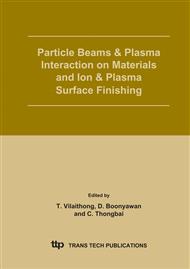p.25
p.31
p.37
p.43
p.47
p.51
p.55
p.59
p.63
Development of In Situ Atomic Force Microscopy for Study of Ion Beam Interaction with Biological Cell Surface
Abstract:
The interaction between ion beam and biological cells has been studied to apply ionbeam- induced mutation to breeding of crops and gene transfer in cells. Formation of micro-craters has been observed after ion bombardment of plant cells and they are suspected to act as pathways for exogenous macromolecule transfer in the cells. A technique of in-situ atomic force microscopy (AFM) in the ion beam line is being developed to observe ion bombardment effects on cell surface morphology during ion bombardment. A commercial AFM is designed to place inside the target chamber of the bioengineering ion beam line at Chiang Mai University. In order to allow the ion beam to properly bombard the sample without the risk of damaging the scanning tip and affecting normal operation of AFM, geometrical factors have been calculated for tilting the AFM with 35 degree from the normal. In order to avoid vibrations from external sources, mechanical designs have been done for a vibration isolation system. Construction and installation of the in-situ AFM facility to the beam line have been completed and are reported in details.
Info:
Periodical:
Pages:
47-50
Citation:
Online since:
October 2005
Keywords:
Price:
Сopyright:
© 2005 Trans Tech Publications Ltd. All Rights Reserved
Share:
Citation:


